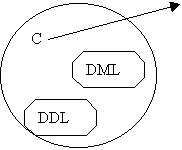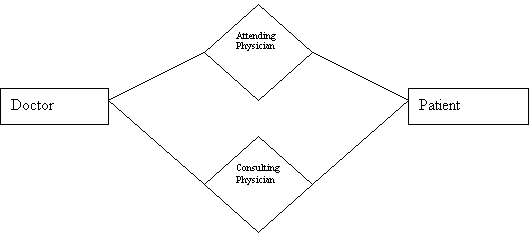Introduction to
Database Concepts
A Database is a collection of data for describing the activities of an enterprise.
A Database Management System (DBMS) is software that is designed to create, access, maintain a database in an effective (functional) efficient (cost) manner.
1st database system is IMS (an IBM system) (hierarchical model) developed in 1960s.
Relational model, 1970, E. F. Codd.
Transactional management.
![]()


 File
Systems vs. DBMS
File
Systems vs. DBMS
-
![]() File systems coordinate only the
physical access.
File systems coordinate only the
physical access.
-
![]() DBMS
coordinate both physical & logical access.
DBMS
coordinate both physical & logical access.
![]()
DBMS
DBMS:
1) Provides data independence (physical; changing file structures
![]() wont affect user
application)(logical)
wont affect user
application)(logical)
 2)
Reduces data redundancy; we have one central storage
2)
Reduces data redundancy; we have one central storage
3) Provides security.
4) Provides data integrity (correctness).
5) Provides concurrent access & crash recovery.
6) Reduces application development time.
File System
DBMS Architecture


DBMS
Query
![]()
![]()
![]()
Results
View 1 View 2 View n
External Level
Conceptual Level![]()

![]()

.
. . . . . . . . . . . . . . . . . (External
Schema)
Physical Level![]()
![]()
Conceptual
Schema
![]()
 Physical
Schema
Physical
Schema
External Schema -> is what a user wants to see
Conceptual Schema -> describes data in terms of the data model of DBMS
Physical Schema -> specifies storage details
Steps in setting a DBMS
1)
![]() Define a model containing all
appropriate types of data and data relationships. E - R
Define a model containing all
appropriate types of data and data relationships. E - R
2) Define integrity constraints on the data (e.g. a dependent can exist with an employee) Entity Relationship Model
3) Define the conceptual schema for the model.
4) Define the physical level.
5) Define views.
6) Initiate (create) database.
7) Give access rights to users.
DBA: Database Administrator
Functions of DBA:
- Creates schema definitions
- Defines storage structures and access methods
- Modifies schemas when necessary
- Specifies integrity constraits.
DBMS Languages
DDL: Data Definition Language
DML: Data Manipulation Language

Host Language; Usually C or Cobol

Data Sublanguages

 Formal Query Language Types
Formal Query Language Types
Calculus (Declerative) Algebra (Procedural)
Optional Languages:
o SQL: Structured Query Language (influenced by calculus)
o QBE: Query by Example
Query Optimization
![]() Query
Query
![]() Query
Parser
Query
Parser
![]() Optimizer
Optimizer
![]() Operator
Evaluator
Operator
Evaluator
![]()
![]() File
& Access Methods
File
& Access Methods
Entity
Relationship Model
Introduced by Peter Chan, 1976, ACM Transactions on Database Systems, Vol I, no, I
Developed to facilitate the logical design of a database for an enterprise
![]() Entities
Entities
![]() Real
World
Real
World
Relationships among entities
Entity: An object that exists and that is distinguishable from other objects
![]()
![]() e.g. Student Account
at Bilkent
e.g. Student Account
at Bilkent
Customer Patient
Ali Patient 12345
Entity Set -> is a set of entities of the same type


students employees
Attributes:
All members of an entity set have the same common properties
Student: stuNo, stuName, stuMajor, gpa
Account: accNo, balance, accountOwner, openDate
Domain -> set of values from which an attribute receives values


gpa dateOfBirth
Mapping -> an attribute is a function, which maps on an entity set into a domain
An entity is described by a set of pairs, one pair for each attribute. <attribute, value>
{<stuNo, 1> <stuName, Ali> <stuMajor, CS> <gpa, 3.5>}
![]()
an instance of
entity type student
Entity Entity set
int instances
real int I, J
char
Relationships
& Relationship Sets
We can relationship between two or more entities
Doctor --- Patient
Student --- Professor
Relationship set: A set of relations of the same type
Formally,
let E1, E2, ... , En be entity sets, not necessarily distinct, the the
relationship
Set
R is a subset of ;
R
Ν { (e1, e2, ... , en)
| e1 Ξ E1, ... , en
Ξ
En }
![]()
![]()
![]()
![]()
![]()
![]() Customer Account
Customer Account


![]()
![]()
Customer
Account Relationship


M N
Instance
1/2001

![]()
![]()
![]()
![]()
![]() E1 D1 E1 = Ali D1
= Gύda
E1 D1 E1 = Ali D1
= Gύda
![]() E2 D2
E2 D2
10/2000 7/1997 5/1999
E3


![]() E2 = Ahmet
D2 = Giyecek
E2 = Ahmet
D2 = Giyecek
![]() E3
= Ayώe
E3
= Ayώe
Example: Ternary Relationship set
Patient Test Doctor
![]()
![]()

![]()
(n_ary, n = 3)
M N
Interpretation:
P A doctor can
perscribe several tests
for
several patients; a test can be
prescribed
by several doctors fo several
patients;
and a patient can have several
Branch Customer Account![]()

![]()
![]()
tests
prescribed by several doctors.
N M
P
Roles:
The function that an entity plays in a relationship is called its role.
Generally, roles are implicit.
Sometimes
roles are specified explicitly to clarify the meaning of a relationship.

Multiple Relationship Sets on
the same Entity Sets
Two
relationship sets between the same entity sets
I W

M
N
Constraints
An E R enterprise Schema allows explicit
specification of certain type of constraints; which are the
constraints that the database contents must always
confirm.
The semantics (meaning) of data is partly captured
by constraints.
1.Mapping Cardinalities
1.1
One to one
1.2
One to
many
1.3
Many to
one
1.4
Many to
many
2. Existance Dependencies
If
the existance of entity X depends on the existance of entity Y, then X is existance
dependent on Y.
![]()
![]()
Subordinate
entity dominant
entity